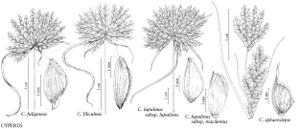Cyperus sphaerolepis
Linnaea 35: 609. 1868.
Herbs, perennial, rhizomatous. Culms basally cormlike, trigonous, (8–)15–40(–60) cm × (0.4–)0.8–1.5(–2) mm, glabrous or sparsely to densely scabridulous to minutely scabrid on angles or usually on surface, just proximal to bracts or over distal few centimeters. Leaves (1–)3–4, V-shaped, (7–)15–25(–40) cm × 1–3(–5) mm, sparsely minutely scabridulous on margins and keel in distal 1/3, otherwise glabrous. Inflorescences: spikes 1–3, sessile (occasionally 1 spike on peduncle 5–20 cm, produced from axil of distalmost leaf), loosely cylindric to oblong-ovoid, (9–)15–30(–45) × (3–)8–15(–18) mm; bracts 2–3(–7), longest erect, or very nearly so, others spreading, (1–)3–20(–26) cm × (0.5–)1–3(–5) mm; rays (1–)2–6(–11), (1–)2–7(–12) cm, in some depauperate plants rays less than 1 cm; rachilla ± deciduous, wingless. Spikelets (4–)8–25(–35), oblong-ellipsoid to linear, compressed-quadrangular, (2–)7–11(–15) × (2–)2.4–3.2(–3.5) mm; floral scales (1–)4–8(–14), laterally dull whitish, stramineous, or light brown, or reddish brown to deep red, often red-dotted especially near keel, medially greenish, broadly ovate-deltate to ± orbiculate, laterally strongly 3(–4)-ribbed, medially weakly 1–3-ribbed, (1.6–)1.8–2.4 × (1.8–)2.2–2.8 mm, margins clear, erose especially apically, apex obtuse, tipped with straight mucro 0.1–0.2(–0.3) mm. Flowers: anthers 0.4–0.6 mm; styles 0.4(–0.8) mm; stigmas 0.6–1 mm. Achenes finely reticulate with isodiametric cells, this layer gradually wearing away to reveal inner brown to reddish brown layer, stipitate, ovoid to obovoid, 1.4–1.6(–1.9) × 1–1.3(–1.4) mm, base cuneate to ± attenuate, stipe 0.1–0.2 × 0.2 mm, apex obtuse, slightly apiculate, inner layer papillose.
Phenology: Fruiting summer.
Habitat: Clearings in montane forests
Elevation: 1000–2500 m
Distribution

Ariz., N.Mex., Tex., Mexico.
Discussion
Cyperus sphaerolepis has long been known by the synonym C. rusbyi and has been treated as a variety of C. fendlerianus. Specific status for C. sphaerolepis is supported by B. G. Marcks (1972) and G. C. Tucker (1994).
Selected References
None.
